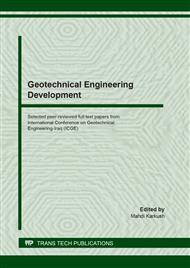[1]
N. Garber, L. Hoel, Traffic and highway engineering, Cengage Learning, (2014).
Google Scholar
[2]
G. Airey, State of the art report on ageing test methods for bituminous pavement materials, International Journal of Pavement Engineering, 4(2003) 165-176.
DOI: 10.1080/1029843042000198568
Google Scholar
[3]
A. Garcia, E. Schlangen, M. van de Ven, D. van VLiet, Induction heating of mastic containing conductive fibres and fillers. Materials and structures, 44(2011) 499-508.
DOI: 10.1617/s11527-010-9644-2
Google Scholar
[4]
T. Al-Mansoori, J. Norambuena-Contreras, R. Micaelo, A. Garcia, Self-healing of asphalt mastic by the action of polymeric capsules containing rejuvenators, Construction and Building Materials, 161(2018) 330-339.
DOI: 10.1016/j.conbuildmat.2017.11.125
Google Scholar
[5]
N. Thom, Principles of pavement engineering, (2008).
Google Scholar
[6]
R. Boyer, Asphalt Rejuvenators Fact, or Fable,. Transportation systems. (2000).
Google Scholar
[7]
B. Huang, G. Li, D. Vukosavljevic, X. Shu, B. Egan, Laboratory investigation of mixing hot-mix asphalt with reclaimed asphalt pavement. Transportation Research Record: Journal of the Transportation Research Board, (2005) 37-45.
DOI: 10.1177/0361198105192900105
Google Scholar
[8]
J. Read, D. Whiteoak, The shell bitumen handbook, Thomas Telford, (2003).
Google Scholar
[9]
T. Lee, R. Terrel, J. P. Mahoney, Test for efficiency of mixing of recycled asphalt paving mixtures, (1983).
Google Scholar
[10]
T. Al-Mansoori, R. Micaelo, A. Garcia, Characterization of polymer capsules used for self-healing asphalt pavements. Functional Pavement Design. Proceedings of the 4th Chinese-European Workshop on Functional Pavement Design, CEW, 2016, England.
DOI: 10.1201/9781315643274-129
Google Scholar
[11]
T. Al-Mansoori, A. Garcia, J. Norambuena-Contreras, I. Artamendi, Self-healing properties of asphalt mixtures with embedded capsules. Advances in Materials and Pavement Performance Prediction. Proceedings of the International AM3P Conference, 2018, Qatar.
DOI: 10.1201/9780429457791-133
Google Scholar
[12]
S. van der Zwag, An introduction to material design principles: Damage prevention versus damage management. Self-Healing Materials, Springer, (2007).
DOI: 10.1007/978-1-4020-6250-6_1
Google Scholar
[13]
A. Bhasin, D. Little, M. Sounir, Intrinsic healing in asphalt binders–Measurement and impact of molecular morphology, (2009).
Google Scholar
[14]
E. Garcia, V. Janez, Rheological aspects of the rejuvenation of aged bitumen. Rheological acta, 45(2006) 474-478.
Google Scholar
[15]
J. Qiu, A. Molenaar, M. van de Ven, S. Wu, J. Yu, Investigation of self-healing behaviour of asphalt mixes using beam on elastic foundation setup. Materials and structures, 45(2012) 777-791.
DOI: 10.1617/s11527-011-9797-7
Google Scholar
[16]
J. Su, E. Schlangen, Synthesis and physicochemical properties of high compact microcapsules containing rejuvenator applied in asphalt. Chemical Engineering Journal, 198(2012) 289-300.
DOI: 10.1016/j.cej.2012.05.094
Google Scholar
[17]
BSI Standard publication, Bituminous mixtures - material specifications. Asphalt concrete, BS EN 13108-1:(2016).
DOI: 10.3403/30213888
Google Scholar
[18]
ASTM D1559, Test Method for Resistance of Plastic Flow of Bituminous Mixtures Using Marshall Apparatus, 1998. http://www.astm.org.
Google Scholar
[19]
American Association of State and Highway Transportation Officials, Standard Method of Test for Effect of Water on Cohesion of Compacted Bituminous Mixtures. AASHTO T 165, (2002).
Google Scholar
[20]
ASTM D88 / D88M-07(2019)e1, Standard Test Method for Saybolt Viscosity, ASTM International, West Conshohocken, PA, 2019, www.astm.org.
Google Scholar
[21]
American Association of State and Highway Transportation Officials, Standard Method of Test for Effect of Heat and Air on a Moving Film of Asphalt (Rolling Thin-Film Oven Test). AASHTO T 240-13, (2017).
DOI: 10.1520/d2872-22
Google Scholar
[22]
ASTM D2872-19, Standard Test Method for Effect of Heat and Air on a Moving Film of Asphalt (Rolling Thin-Film Oven Test), ASTM International, West Conshohocken, PA, 2019, www.astm.org.
DOI: 10.1520/d2872-22
Google Scholar
[23]
T. Al-Mansoori, Encapsulated Healing Agents for Asphalt Self-Healing. PhD thesis, University of Nottingham, Nottingham, UK, (2018).
Google Scholar
[24]
J. Norambuena-Contreras, E. Yalcin, A. Garcia, T. Al-Mansoori, M. Yilmaz, R. Hudson-Griffiths, Effect of mixing and ageing on the mechanical and self-healing properties of asphalt mixtures containing polymeric capsules. Construction and Building Materials, 175 (2018) 254-266.
DOI: 10.1016/j.conbuildmat.2018.04.153
Google Scholar


